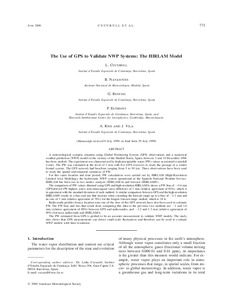Por favor, use este identificador para citar o enlazar este ítem:
http://hdl.handle.net/20.500.11765/11811
The use of GPS to validate NWP systems: the HIRLAM model
Registro completo de metadatos
| Campo DC | Valor | Lengua/Idioma |
|---|---|---|
| dc.contributor.author | Cucurull, Lidia | es_ES |
| dc.contributor.author | Navascués, Beatriz | es_ES |
| dc.contributor.author | Ruffini, G. | es_ES |
| dc.contributor.author | Elosegui, Pedro | es_ES |
| dc.contributor.author | Rius, Antonio | es_ES |
| dc.contributor.author | Vila, Jordi | es_ES |
| dc.date.accessioned | 2020-05-13T11:47:05Z | - |
| dc.date.available | 2020-05-13T11:47:05Z | - |
| dc.date.issued | 2000 | - |
| dc.identifier.citation | Journal of Atmospheric and Oceanic Technology. 2000, 17, p. 773–787 | es_ES |
| dc.identifier.issn | 0739-0572 | - |
| dc.identifier.issn | 1520-0426 | - |
| dc.identifier.uri | http://hdl.handle.net/20.500.11765/11811 | - |
| dc.description.abstract | A meteorological synoptic situation using Global Positioning System (GPS) observations and a numerical weather prediction (NWP) model in the vicinity of the Madrid Sierra, Spain, between 2 and 15 December 1996 has been studied. The experiment was characterized by high precipitable water (PW) values associated to rainfall events. The PW was estimated at the level of 1 mm with five GPS receivers to study the passage of a winter frontal system. The GPS network had baselines ranging from 5 to 50 km. These observations have been used to study the spatial and temporal variations of PW. For this same location and time period, PW calculations were carried out by HIRLAM (High-Resolution Limited Area Modeling), the hydrostatic NWP system operational at the Spanish National Weather Service. HIRLAM has been run in two modes: analysis (HIRLAM/A) and forecast (HIRLAM/F). The comparison of PW values obtained using GPS and high-resolution HIRLAM/A shows a PW bias of 20.4 mm (GPS-derived PW higher), and a root-mean-square (rms) difference of 2 mm (relative agreement of 85%), which is in agreement with the standard deviation of each method. A similar comparison between GPS and the high-resolution HIRLAM/F results in a bias and rms that increase when extending the forecast range up to a bias of 21.2 mm and an rms of 3 mm (relative agreement of 78%) for the longest forecast range studied, which is 24 h. Radiosonde profiles from a location near one of the sites of the GPS network have also been used to estimate PW. The PW bias and rms that result from comparing this data to the previous two methods are 21 and 1.6 mm (relative agreement of 88%) between GPS and radiosondes, and 21.2 and 1.3 mm (relative agreement of 90%) between radiosonde and HIRLAM/A. The PW estimated from GPS is probed to be an accurate measurement to validate NWP models. The study also shows that GPS measurements can detect small-scale fluctuations and therefore can be used to evaluate NWP models with finer resolution. | es_ES |
| dc.description.sponsorship | This work was supported by Spanish Climate CICYT Grant CLI95-1781, EC Grant WAVEFRONT PL-952007, and MAGIC PL-972065. | es_ES |
| dc.language.iso | eng | es_ES |
| dc.publisher | American Meteorological Society | es_ES |
| dc.subject | HIRLAM model | es_ES |
| dc.subject | Numerical weather prediction | es_ES |
| dc.subject | Global Positioning System | es_ES |
| dc.title | The use of GPS to validate NWP systems: the HIRLAM model | es_ES |
| dc.type | info:eu-repo/semantics/article | es_ES |
| dc.relation.publisherversion | https://dx.doi.org/10.1175/1520-0426(2000)017<0773:TUOGTV>2.0.CO;2 | es_ES |
| dc.rights.accessRights | info:eu-repo/semantics/openAccess | es_ES |
| Colecciones: | Artículos científicos 2000-2004 | |
Ficheros en este ítem:
| Fichero | Descripción | Tamaño | Formato | ||
|---|---|---|---|---|---|
| On_the_use_of_GPS.pdf | 284,06 kB | Adobe PDF |  Visualizar/Abrir |
Los ítems de Arcimis están protegidos por una Licencia Creative Commons, salvo que se indique lo contrario.





